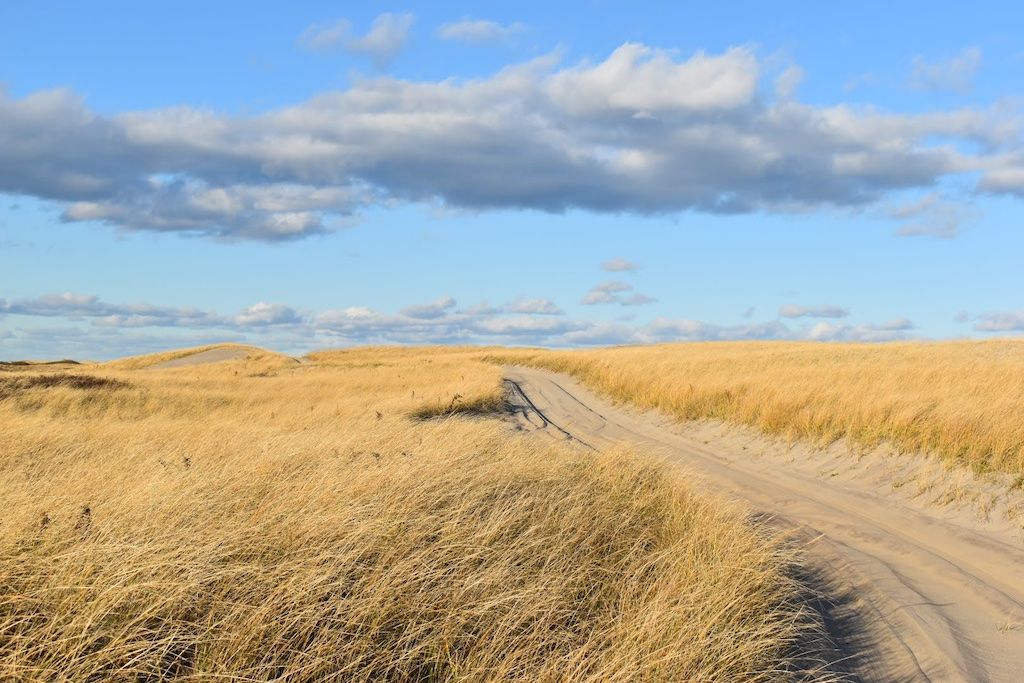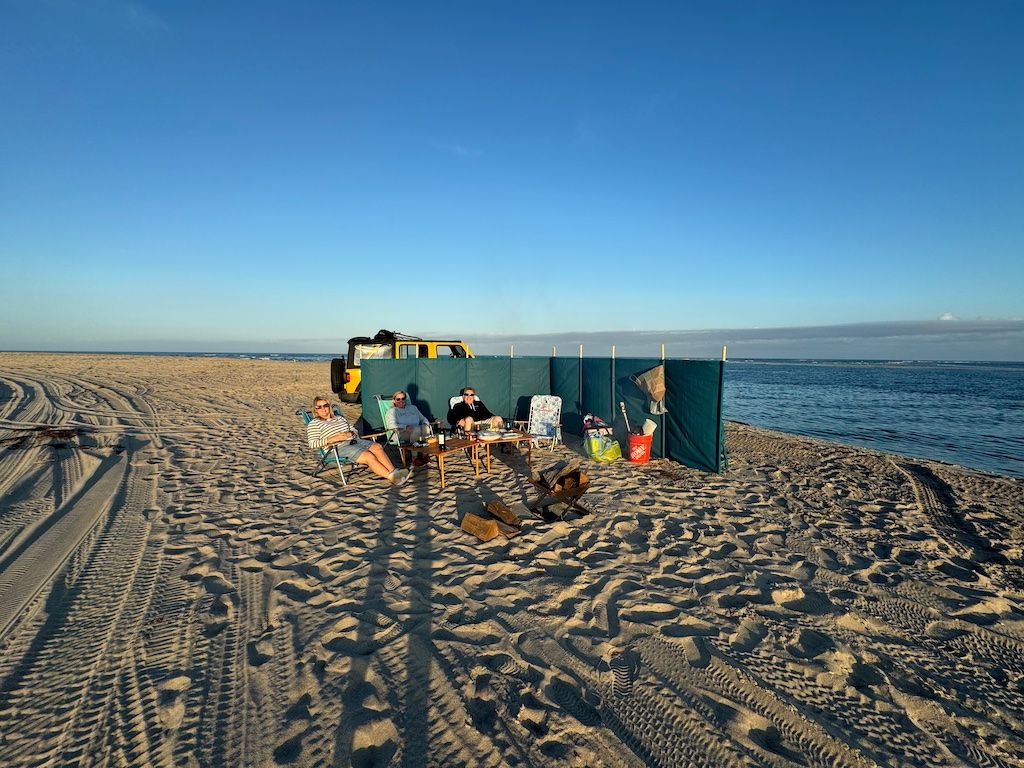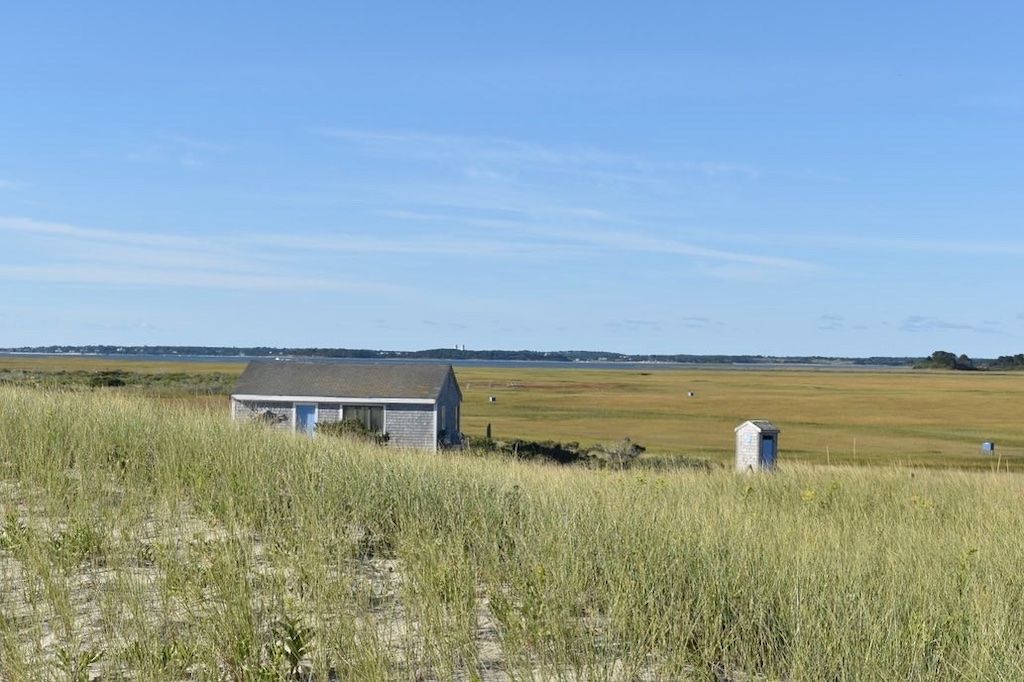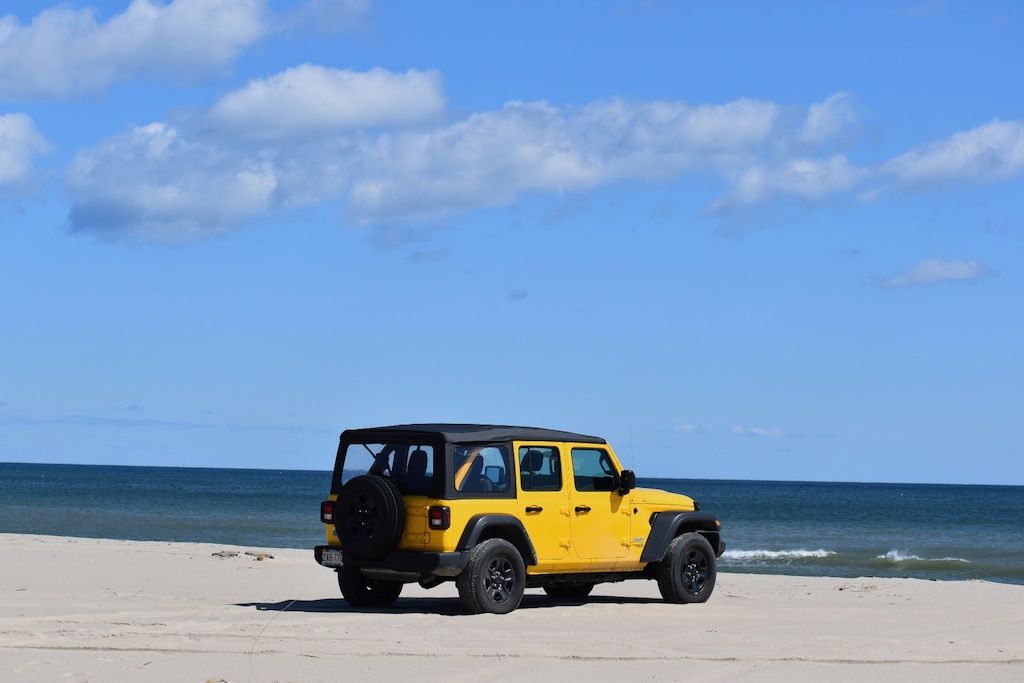One of my favorite things to do on Cape Cod is to go oversand to the Outer Beach. The beach, which stretches for almost nine miles from the Nauset Inlet in Eastham to the North Cut in Chatham, consists of pristine waterfront, rolling dunes, fields of beach grass, green hummocks, rustic cabins (“camps”), and countless stunning vistas. This area is actually a barrier beach - a land barrier that protects the Nauset Estuary and Pleasant Bay from the Atlantic Ocean - ensuring these estuaries remain protected ecosystems that function as nurseries for Cape Cod. While not all the nine miles is accessible to oversand vehicles, there are two trails: one to the north of the Nauset Beach parking lot (a.k.a. Nauset Beach North) and another to the south (a.k.a. Nauset Beach South). If you are new to oversand on the Outer Beach, consider this your primer for getting started.
Accessing The Trails
The division between the two trails - Nauset Beach South and Nauset Beach North - is the parking lot of Nauset Beach. The access varies based on the trail you use.
Nauset Beach North
Nauset Beach North is used almost exclusively for day trips to the beach, and usually fills up quickly in the summer due to its limited space. This trail goes on to the Nauset Spit, which is the two mile long barrier beach protecting the Nauset Estuary from the Atlantic Ocean. The trail is accessible from Callanan’s Pass in Nauset Heights and goes about a mile north before it reaches a turnaround at the Eastham town line (Eastham does not allow driving on the beach). In addition to day trippers, you will also sometimes see fishermen using this trail to bring their gear on to the Spit for night fishing. I’ve run into a few striped bass beach blitzes walking this spit in the evenings, so I can confirm there is some good night fishing up this way. Unfortunately there are no tire pumps available, so make sure to bring your own.
Due to erosion from an autumn 2022 storm, this trail was closed for almost two years and only re-opened in June 2024. Given this history, make sure to check its status with Orleans Natural Resources before heading out.
Nauset Beach South
The entrance to Nauset Beach South is through the main beach parking lot. The trail goes about five miles to the North Cut inlet in Chatham, and is used for trips to the beach, overnight camping (Self Contained Vehicles only), fishing, dinner & drinks on the beach, and just joy riding across the sand. You can access this trail through the main entrance to Nauset Beach, where an oversand permit will allow you to get on the trail. This trail also has the benefit of having tire pumps available in-season when you come off the beach (note: off-season you need to bring your own pumps). There are seven beaches off the main trail, each with a number that starts at 1 and going to 7. But depending on erosion and dune drift, some of these paths will be closed. Starting around beach 5 you will leave Orleans and enter Chatham, which their residents refer to as "North Beach."

Getting a Permit
Access to the beaches requires a 4WD vehicle and a valid oversand permit from the towns of Orleans or Chatham. As of the 2023-2024 season, the permit cost for Orleans residents is $136, $386 for non-residents, and $466 for Self-Contained Vehicles (a.k.a. SCV, such as an RV). All three permits will give you access to Nauset Beach South, but Nauset Beach North is only available for Orleans residents.
Before applying for the permit, ensure your vehicle meets the specific tire requirements, and that you have the required safety equipment - e.g. shovel, tow rope, jack, tire gauge, spare tire. All of this is outlined in the Nauset Beach Rules & Regulations. If you plan to use your permit in the offseason, you will also want to get your own tire pump(s), since the town-owned air pumps are removed in the winter.
A first time permit can be obtained by going in-person to the Orleans Sticker Office, filling out an application, watching a safety video, and having your vehicle inspected. Make sure you have read the rules & regulations in advance, which outline everything you need to know in order to safely use the Outer Beach. After getting this first permit, you can bypass the Sticker Office and renew your vehicle in subsequent years online.
When It’s Open
The trails are open year round from 6 AM to 11 PM. In the off-season, the Outer Beach is only lightly used, but by late July and August, it is filled with vehicles. You can stay on the beach past 11 PM under two conditions: 1) if you are staying in a Self-Contained Vehicle, or 2) if you are “actively fishing.” All of these and all other regulations are managed by the Orleans Natural Resources department, who are usually a pleasure to interact with.
Periodically the beaches will close, which is announced in advance by Natural Resources. I would suggest following them on Instagram or Facebook to ensure you see all updates. There are three types of closures: 1) maintenance, 2) storm, and 3) habitat conservation (Nauset Beach South only). The first two are the easiest to discuss and are also the least controversial for permit holders. Maintenance closures usually occur in late spring before the start of a new season and last 1-2 days. Storm closures happen infrequently, will be announced in the same way as maintenance, and will last a day or two (which is typically before a major storm arrives until after Natural Resources has inspected the beach). The third closure - and the most controversial - is for the piping plover habitat conservation on Nauset Beach South.
Piping plover populations had plummeted on Cape Cod prior to federal protection for the species, and have only recently shown signs of rebounding. A Habitat Conservation Plan (HCP) closure will typically start in late May / early June after the nesting starts, and the trails will remain closed until the majority of the nesting has completed (typically mid to late July). As the number of nesting pairs dwindle, the beach will typically have a limited opening based on the Habitat Conservation Plan, which makes some of the beach accessible for day trippers - no SCV overnight stays - as long as you have someone to walk ahead of your vehicle to look for plovers in protected sections. During this restricted opening, you will be required to show a signed copy of the HCP, which must be kept in your vehicle at all times.
Since the Outer Beach actually spans two towns - Orleans and Chatham - you will find the restrictions will vary slightly by town. Typically you will find the HCP closure to last longer on the Chatham sections of the Outer Beach. The Chatham closures however are always announced by Orleans Natural Resources, so following them on social media will ensure you are aware of all restrictions.
I have never personally had an issue with these restrictions, and am happy to stay off the beach to help the population of plovers. But I also understand how this upsets out of town residents who only get to use their permit for a few weeks in the summer. This summer I saw one RV flying a big flag with a plover covered by a red circle with a slash through it. My only advice to people upset by the HCP closure is not to direct it at Natural Resources, who are just implementing the restrictions set by the federal government.
Airing Up & Down
Since 2023, access to Nauset Beach is through an entrance on the right of Beach Road. There are now two parking lots: the upper one you pass through after entering, and the lower one that is located right behind the beach. Before entering Nauset Beach South, you will find a well marked area set aside for airing down your tires. Pull your vehicle in here and begin airing your tires down to 15 PSI (note: only Tom Brady is allowed to air down to 10 or 12 PSI). You can then pull forward to the sand trail ahead, stop at the guard house for a permit check (in season), and then head on the beach.
You can air up quickly at one of four stations to the left of the guard house when you come off the beach. There is no faster way to ruin your tires than trying to drive any distance on the paved streets while aired down. If all the air pumps are being used, just wait in line for the next available station to open up. Orleans Conservation keeps these stations running for as long as possible, so it is not uncommon to find them available from March to November.
My basic philosophy when it comes to airing up / down is this: the less time you spend doing it, the more time you have to enjoy the beach. Years ago I bought four brass tire deflators made by an Australian company that have become integral to my air down process. When I arrive at the air down area, I screw the four deflators on my tire and wait while they rapidly bring me down to 15 PSI. I also bought two tire pumps that plug into my two Jeep outlets, so in the off-season I can inflate my tires as quickly as possible (although nothing is faster than the air up at the stations when they are available).
When To Go
Now that you know when it is open, let’s discuss when to go.
Nauset Beach South
If you are going for just a ride to enjoy the beauty of the landscape or to take photos, you will likely find the offseason to be the most enjoyable time. The crowds substantially slow after Labor Day, and from October through May it is mostly empty. If you are looking to camp overnight in your SCV, you will be restricted by warm weather and HCP closures. The busiest time for SCVs on the beach is usually immediately after reopening after HCP closure / restrictions in early August, and going through early September. And finally, if you are looking for a day trip to the beach, any warm day from May through October is a great day to be on the Outer Beach.
Nauset Beach North
As I mentioned previously, Nauset Beach North may or may not be open depending on storm damage. The 2022-3 closure came from a storm that may be the result of the nodal point shift we are seeing on the backside of the Cape that is expected to move the Nauset Inlet south toward Nauset Heights. When this trail is open, it gets used by day trippers for going to the beach, and usually fills up in the summer by mid-morning.
What To Do
Both Nauset Beach North and South get used by people who like to swim, surf, boogie board, fish, play volleyball or other beach games, and sit around a fire to enjoy some food and drink. My favorite activity is to park on the beach along the Atlantic coast with a view to Pleasant Bay, put up my wind breaks, start a warm fire, and bring out the appetizers and drinks. Sometimes we even cook up some lobster rolls over the fire. There is nothing like enjoying a beautiful summer or autumn afternoon with friends or family on the Outer Beach. It’s one of those experiences that remind you of the special place we have the privilege to live / visit.
But I also like to come to the beach in the offseason for a drive, to enjoy the scenery, and to take photographs. The beach changes with the seasons, from the vibrant greens of the summer to the pale yellows of the winter. In the offseason Natural Resources takes down the rope barriers between the numbered beaches on Nauset South, allowing you to travel all the way down to Chatham along the beach (tides willing).

What To Bring
Kristin and I are constantly revising our packing list in order to improve the experience. Always plan for it to be colder and windier on the beach than you expect - especially if you go all the way to beach 7 by the North Cut. Here are some of the items on my packing list:

- Beach chairs
- Portable table(s)
- Portable grill - beach fires must be contained
- Wood
- Firestarter - e.g. empty egg cartons
- Fire stick - butane torch works best when you have wind
- Wind breaks - must have on windy days
- Lanterns
- Plastic wine glasses, paper plates / bowls, napkins
- Knives / forks
- Skillet - if cooking on beach
- Cooler with appetizers & food
- Drinks - wine, beer
- Wine / bottle opener & wine bottle stopper
- Stuff for s'mores - graham crackers, chocolate, marshmallows, sticks
- Sunscreen
- Binoculars - for shark sightings
- Garbage bags - 1 garbage, 1 recycling
- Paper towels / wet ones
- Blankets - if cool
- Bluetooth speaker - e.g. Sonos
- Grill gloves
- Personal beach attire - e.g. sunglasses, swimsuit, hat, sweatshirt, towels
- Beach toys - e.g. volleyball / pickleball gear, standup paddle board
The History
If history isn't your jam, you can safely skip this section. But the history nerd in me cannot help telling you a little bit about the story of our Outer Beach:
The last Ice Age carved out the coast of Massachusetts, leaving behind a trail of sand and rubble that formed Cape Cod. As the sea levels rose and plants and animals returned, human habitation began about 12,000 years ago. While we don’t know much about the earliest inhabitants, we do know that for the last several thousand years the land was settled by a peaceful Native American tribe called the Nausets. Due to its remote location and absence of trees, the Outer Beach was likely used solely for fishing and shellfishing by the Nausets, who established farms on the heights behind the beach. The northern section of Nauset Beach, known as “The Spit”, makes its first appearance in recorded history on Samuel de Champlain’s 1605 map of Cape Cod, where it shows an area that appears thickly settled.
Prior to the arrival of the Pilgrims in 1620, a pandemic rolled like a wildfire through the native population in North America, killing up to 90% of the natives of New England. When the Pilgrims arrived in the New World, they found empty plowed fields and villages, which they attributed to the “providence of God.” The Pilgrims stayed on Cape Cod for only five weeks, during which they explored the bay side and made a failed attempt to leave for Long Island. If you were standing on the Outer Beach on December 20, 1620, you might have seen the Mayflower pass offshore in what was called the Turning Point.
The Puritans would be the first of a wave of religious emigration to the New World called the Great Puritan Migration. The rapidly growing population would spawn a growing need for more land, which eventually brought the settlers to Cape Cod. While much of the surrounding land was cleared of trees for farming by the English, the Outer Beach remained mostly untouched, looking today much as it would have then. These settlers would build their homes in safer areas that were located well back from the water, and used Nauset Beach primarily for harvesting salt hay used for their livestock.
In the 19th century, the Outer Beach started to be used by locals for hunting ducks and geese. While at first this was done to put food on the tables, eventually out-of-towners showed an interest in hunting expeditions. This would be the start of the more regular use of the remote areas of Nauset Beach, with a few enterprising locals forming hunting clubs to cater to visitors. Babe Ruth and Ted Williams are among the notable people known to have hunted here. What started with crude wooden lean-tos in order to rest during a hunting trip evolved by the early 20th century into land being purchased for the construction of rustic cabins known as “camps.”

Over the years the barrier beach has undergone substantial changes, as it broke apart and reformed in what is believed to be a 400 year cycle. Up until 1958, it would have been possible to walk all the way from Nauset Beach in Orleans to the southern tip of Monomoy - a distance of over 12 miles - without ever having to cross the water. But a series of breaks over the years have created new inlets that separated Monomoy from the mainland (1958), broke Monomoy into two islands (1978), created an inlet east of Chatham Light (1987), and turned the current North Beach into an island (2007). The latter storm created North Inlet, which is located at the southernmost tip of the Outer Beach on beach 7.
Access to the Outer Beach prior to the 1950s was done primarily by walking, boat or horse. But with the end of World War II, an excess inventory of Jeeps brought a new form of transportation to Nauset: the beach buggy. The new ease with which the beach could be accessed changed both its use and accessibility, resulting in a rapid increase in interest to this previously remote area. The rise in use resulted in the first informal rules for using the beach, which were followed by formal rules and regulations after the land was purchased in the 1950s by the towns of Orleans and Chatham.
While today there are only 13 camps remaining on Nauset Beach South, there were once over 70, with the majority arranged into what was called First Village and Second Village (approximately in the areas of beaches 5 and 7). Erosion caused a slow loss of camps in the villages, with the 2007 storm resulting in the loss of all but a few camps on North Island. Today there is only one camp left on North Island from the two villages that once resided here.
While there is much more history to tell here - e.g. the pirate gold on an island in Pleasant Bay, the pirate ship that was stranded in a storm nearby, the backstory behind this becoming owned by the towns of Orleans & Chatham - but I'll let you do your own research to continue the journey into this amazing place we have the privilege to use.
Last Thoughts
Hopefully this will get you started enjoying one of the truly unique experiences of living in and around Orleans: the Outer Beach. Please feel free to reach out to me directly if you have any questions - I know how intimidating it can be to make that first trip.
Happy trails.
